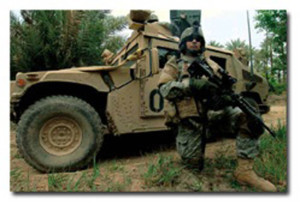
Protective materials for military and law enforcement have improved—and so has the market for them.
Technology, like in many other industries, has dramatically redefined the advanced textile industry. The creation of advanced materials has transformed traditional fabric, chemical and metal production and continues to push the boundaries. Advanced textiles, a subset of advanced materials, include new types of composite nonwovens and laminates, nonwoven finishing techniques, and superior fiber and textile additives. In particular, advanced textiles represent a new generation of textiles manufactured primarily for their technical and functional properties. Materials are now being produced that can be manipulated, modified and tailored to precisely meet the needs of any particular customer or industry.
This article will examine the protective apparel textile industry in ballistic applications and materials and distinguish between the traditional textile industry of the past and the modern components of the industry that represent the future. Advanced textiles trace their roots to the traditional textile industry, and any exploration of future growth must take this inclusive view. Advanced ballistic textiles represent the technological and innovative segment of the larger traditional textile market.
Growth projected
The protective clothing market is projected to register a compound annual growth rate (CAGR) of 6.2 percent between 2015 and 2020, and is expected to reach a market size of $9.3 billion by 2020. The North American region is the largest market for protective clothing, as well as having the highest demand for it, and is projected to retain this position over the next five years. Thermal protective clothing is the largest application in North America and is driving the demand for protective clothing.
Key factors driving the protective clothing market include growth of end-user industries for protective clothing for thermal and mechanical applications. Strong governmental regulations requiring the use of protective clothing in industries have increased the demand for protective clothing. Factors challenging the growth of this market are high prices for specialized protective clothing and increased automation in end-use industries.
Competition is intense in the protective clothing market. Major players made an impact on the market by developing materials and implementing modern technologies. Market leaders have patented fabrics with superior properties and characteristics.
The protective clothing market is highly concentrated; the top five players had more than 60 percent of the market share in 2014. These major players are the most active in strategic developments including mergers/acquisitions, expansions and partnerships.
Among the key market participants are Ansell (U.S.), Lakeland Industries Inc. (U.S.), Teijin Ltd. (Japan), Kimberly-Clark (U.S.), Sioen Industries NV (Belgium), E.I.DU Pont De Nemours and Co. (U.S.), Honeywell International Inc. (U.S.) and 3M (U.S).
Ballistic fabrics
The right clothing and equipment is vital to the survival and effectiveness of military personnel. Research into new materials and applications has included anthropometric methods and the study of psychological, color and camouflage issues related to the successful design of military textiles.
Innovations in ballistic textiles include traditional high performance fiber technology improvements, as well as newly developed technologies. Recent ballistic textile developments have been geared toward reducing product weight while increasing performance to provide warfighters military personnel and police officers with better protection that also is more comfortable and manageable.
National Institute of Justice (NIJ) standards used to certify ballistic armor products have been updated recently to require compliance with more stringent parameters, particularly with regard to durability of the antiballistic function.
Well-established premium ballistic fibers, including aramid and high-modulus polyethylene (HMPE), are available in increasingly effective, lighter weight, more cost-effective versions for both soft armor, such as bullet-resistant vests, and hard armor, such as helmets, shields, body armor plates and vehicle armor.
Several interesting innovations using recently developed materials or involving new applications for established high-performance fibers may provide alternatives to the traditional materials or may be used in conjunction with them to enhance armor products in various ways.
For example, Teijin’s Twaron is a high-performance fiber with multiple performance qualities used in ballistic protection. Endumax® is the company’s newest high performance material, a pure UHMWPE (ultra high molecular weight polyethylene) tape—the strongest available at its weight. Protective unidirectionals and composites made from this material have a very high degree of braking energy and particularly high stopping power for bullets and fragments.
Graphene’s performance
Layers of carbon one-atom thick can absorb blows that would punch through steel. Recent tests suggest that pure graphene performs twice as well as the fabric currently used in bulletproof vests, making it an ideal armor for soldiers and police.
Graphene is a sheet of single carbon atoms bonded together in a honeycomb shape. Because it is an excellent conductor of heat and electricity, graphene is already used in computers and electronics, but it’s also incredibly strong for its slight weight
However, it’s tricky to fire high-speed shots through such a thin material to test its toughness because atom-thick material is completely destroyed by such an impact. Previous work used “nano-pokers” to push into graphene at walking speed (less than a meter per second) or a shotgun approach using several laser pulses. But these methods don’t provide evidence of graphene’s real strength in the face of a high-speed projectile, say researchers at the University of Massachusetts Amherst. Much work would be required for commercialization.
The team found that graphene sheets dissipate this kinetic energy by stretching into a cone shape at the bullet’s impact point and cracking outward radially. The cracks are one weakness of single-layer graphene, the research shows, but it nevertheless performs twice as well as Kevlar® and withstands 10 times the kinetic energy of steel. Using multiple layers of graphene or incorporating it into a composite structure could keep the cracks from spreading.
Established materials
Kevlar® by Wilmington, Del.-based DuPont is offered in several versions to protect against bullets, sharp objects, shrapnel or a combination of threats. The newest is Kevlar® XP™ that has a woven/laminated construction with attributes of both woven and unidirectional technologies.
The company says the product can stop a .44 Magnum bullet within the second or third layer of an 11-layer design. As much as a 15 percent back-face deformation reduction comes from the energy-absorbing capability of the remaining layers of material. Fewer layers of fabric are needed to provide the performance, resulting in up to 10 percent weight reduction and potentially reduced costs to construct a vest. The product is being used in soft bullet-resistant vests, but future applications include hard armor such as platform armor, helmets and personal shields.
Morris Plains, N.J.-based Honeywell reports that its latest-generation Spectra Shield® II ballistic composite material using HMPE fibers is available in several soft and hard armor versions and can provide up to 20-percent greater ballistic performance than the original Spectra Shield technology.
When a greater level of protection is not needed, using the newer technology in place of the older technology can help reduce armor weight by 10–20 percent. According to the company, the U.S. military and the company’s law enforcement customers are specifying the newer technology to replace previous materials in their armor programs.
Honeywell’s Gold Shield® armor materials use less costly aramid fiber incorporated in the technology’s unidirectional construction. The company says it is seeing significant demand for vehicular armor with its Gold Shield GV-2016 composite, which can significantly lower the vehicle’s weight at a cost comparable to older, bulkier armor solutions. It can also provide a high level of protection against bullets, shrapnel and explosions, the company says. Vehicles also may be equipped with explosively formed projectile (EFP) kits made with a Spectra Shield II material to protect against the highest-velocity threats.

Dyneema® soft ballistic (SB) armor solutions are used in vests and clothing to provide life-saving protection against handgun ammunition and knives. Dyneema hard ballistic (HB) armor solutions are incorporated into ballistic inserts and helmets to protect against heavier and more penetrating threats, such as rifles, and high-speed fragments, such as those from IEDs. DSM Dyneema, the Netherlands, maker of Dyneema UHMWPE fibers and yarns, has considerably expanded production capacity at its Greenville, N.C., facility, largely to supply ballistic materials to the U.S. military and law enforcement agencies.
Among the company’s unidirectional hard and soft armor materials are Berry Amendment-compliant HB51, produced specifically for the U.S. HB armor market, and HB26 hard ballistic composite, used for vehicles and helmets and having potential uses in body armor inserts. HB51 is a hybrid construction used as a protective backing behind the armor’s strike face. According to DSM Dyneema, it offers a 20 percent improved ballistic performance over a previous version used by the U.S. military, without adding weight.
HB26 has seen its first commercial use in helmets supplied by Pittsfield, Mass.-based Protech® Armored Products to the Denver Police Dept. DSM Dyneema reports the helmets are 15 percent lighter in weight and exhibit less back-face deformation than comparable aramid helmets. In addition, HB26 requires less handling time and enables increased production speeds.
The company also is developing a tape system for use in vehicle armor to provide lightweight, superior protection against emerging battlefield threats. The first prototype—X32—is currently under evaluation for its effectiveness against such threats.
With Dyneema Force Multiplier Technology, DSM Dyneema offers the lightest weight materials seen in the industry for ballistic armor protection in both personal protection (vests, inserts, helmets, soft armor applications and extremity protection), vehicle armor and next-generation tactical gear that’s engineered specifically for the soldier or law officer.
Andrew D. Park is principal consultant with PTI Consulting, Ashburn, Va., with specific expertise in military ballistics materials. Part II of his article will run later in December. It will discuss newer materials and technologies in the ballistics market.
 TEXTILES.ORG
TEXTILES.ORG


